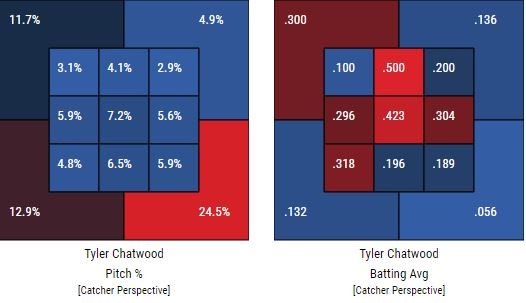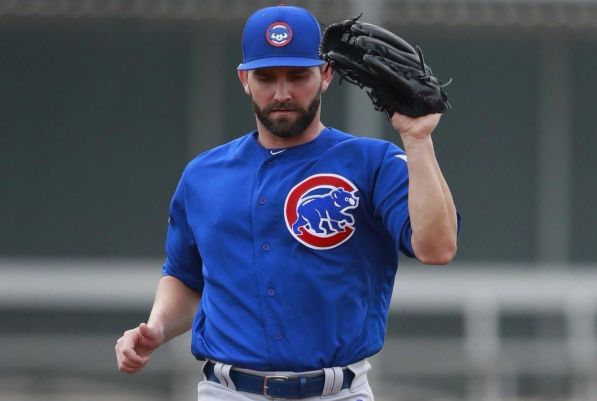| Age: | 28 |
| Bats/Throws: | R/R |
| Height/Weight: | 5'11", 200 lbs |
| Position: | Starting Pitcher |
During his time with the Colorado Rockies (5 years), Chatwood went 34-35 with a 4.18 ERA and 1.49 WHIP. Many Cubs fans might be confused as to why their beloved ball club spent $38 million on a pitcher who has more losses than wins in his career and is coming off an 8-15 season with a 4.69 ERA. Don’t worry, Cubbies, there are plenty of reasons for optimism with the 28-year-old righty.
Do the numbers 5,200 and 135 have any meaning to you? At face value, a fantasy owner may say no, unless they are thinking about potential winnings this season! The first number is the elevation of Coors Field, Chatwood’s former home stadium, while the latter is his new home park, Wrigley Field. Coors Field is a hitter’s paradise and a pitcher’s worst nightmare. It’s a substantial park upgrade for Chatwood in his prime season at a ripe 28 years young.
| IP | ERA | HR | BAA | OBP | SLG% |
2016 Home | 78.0 | 6.12 | 11 | .300 | .375 | .497 |
2016 Away | 80.0 | 1.69 | 4 | .189 | .286 | .272 |
2017 Home | 70.1 | 6.01 | 10 | .299 | .395 | .489 |
2017 Away | 77.1 | 3.49 | 10 | .197 | .299 | .396 |
As you can see from the table above, over the last two years, Chatwood has been two different pitchers, depending on where he’s been pitching. Most pitchers are likely going to be better when leaving Coors Field, but Chatwood has an opportunity to provide excellent value for his fantasy owners this season. With everyone looking into that ugly 8-15 record last year, these are the types of numbers to analyze when determining what exactly Chatwood can be in his new digs.
The Cubs are a slick fielding team and Chatwood will keep his middle infielders busy. Of pitchers who threw more than 140 innings in 2017, only four pitchers generated a higher ground ball percentage than Chatwood. Since the start of 2016, he has the fourth-highest ground ball rate among qualified starting pitchers. The right-hander has posted a ground ball rate of 56 percent higher in three of his last four seasons, and last year’s 21.7 fly ball percentage was the lowest of his professional career. Chatwood’s stuff has always been pretty good, which is encouraging that he generated soft contact (22.1 percent of the time) more than he ever has before.

It shouldn’t come at a surprise that Chatwood is among the game’s elite in terms of generating groundballs. As you can see in the image above (via Baseball Savant), Chatwood absolutely peppers the bottom of the strike zone and very rarely leaves pitching up in the zone.
Chatwood underwent Tommy John surgery in April of 2014, causing him to miss all of the 2015 season. He served stints on the DL in 2016 (back) and 2017 (calf), but since the infamous surgery, his arm has remained relatively healthy. In 2016, his first year back from the surgery, he was averaging 92 miles per hour, 85 miles per hour and 77 miles per hour on his fastball, changeup and curveball respectively. However, in 2017, those marks jumped to 94.8 miles per hour, 88.5 miles per hour and 79 miles per hour. His arm is live, his stuff remains good, and he’s had some success in spring training, most notably a nine-strikeout performance against the Giants in mid-March.
Chatwood generated more swings and missed with his offspeed stuff in 2017 than he did in 2016. Crisp, efficient offspeed will be key to a successful first year with his new ball club. The added speed on his changeup proved effective in 2017, seeing as his swing-and-miss percentage (per Baseball Cube) on the pitch jumped exponentially.
PITCH | 2016 SwMs% | 2017 SwMs% |
Fastball | 8.03 | 7.46 |
Cutter | 15.35 | 16.22 |
Curveball | 8.33 | 11.89 |
Changeup | 6.00 | 20.61 |
In Howard Bender’s Mock Draft Army, Chatwood is currently the 72nd starter off the board, with an average draft position of 285.1. If his road splits are any indicator, he will easily return value on his current cost, and he can be had for pennies on the dollar. He increased his K/9 to 7.31 last season, and increased, or maintained, effectiveness with his fastball and offspeed could lead to another year with an increased K/9. He’ll never be a huge strikeout guy, but he could approach an even 8.0 K/9 this season, especially since he won’t be making half of his starts at Coors Field. It’s imperative that he harnesses his walk rate to a reasonable amount, however if he doesn’t, his groundball prowess can erase free passes rather easily. Nevertheless, the walk rate needs to be closer to 2016’s 3.99 BB/9, compared to 2017’s atrocious 4.69 BB/9.
The 28-year-old right-hander can be had in drafts as your SP4 or SP5, but the opportunity to provide SP3 numbers is well in the realm of possibility. While you don’t want to draft him as your third starter, he presents one of the best draft day values in all of fantasy baseball.

